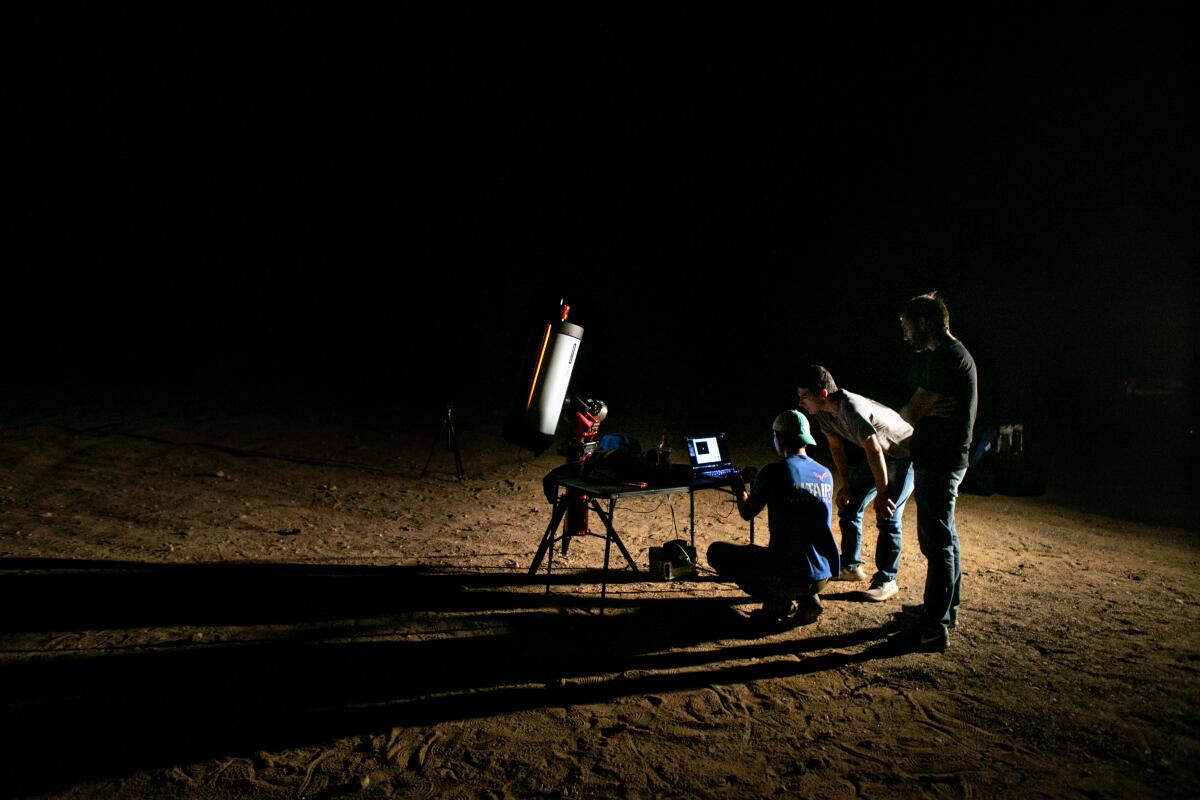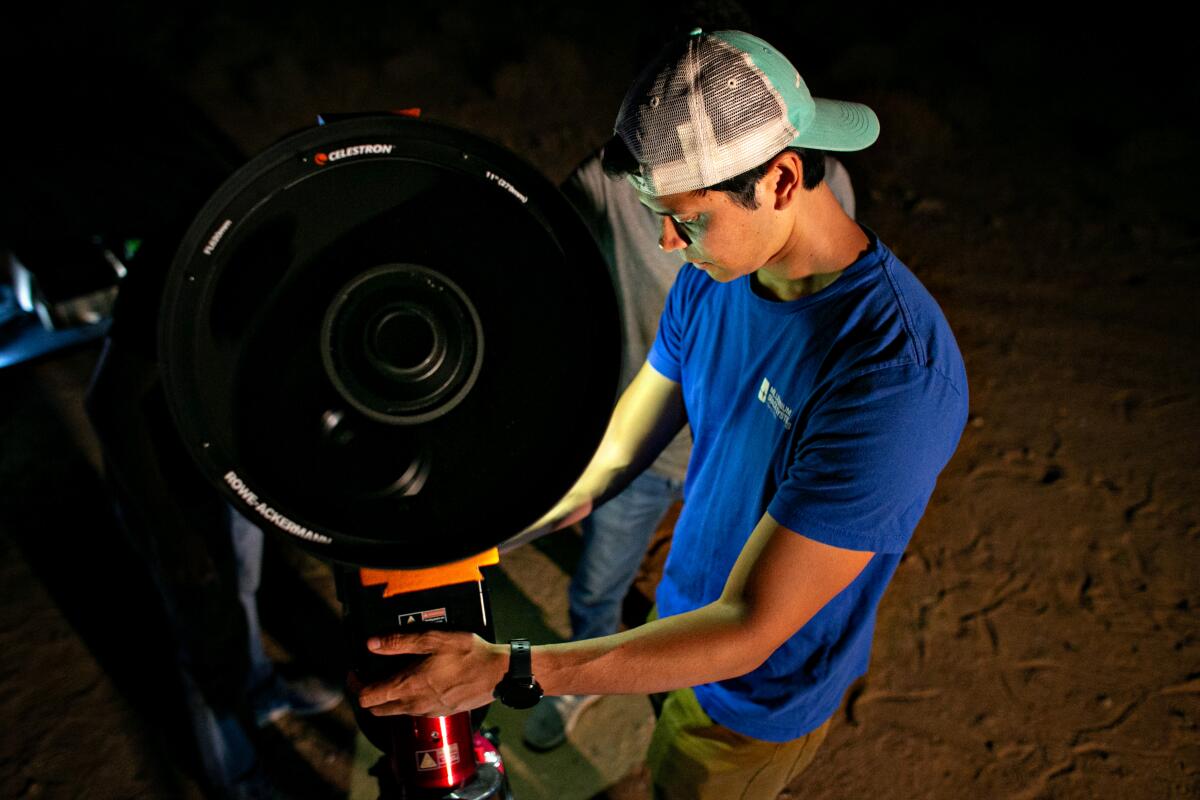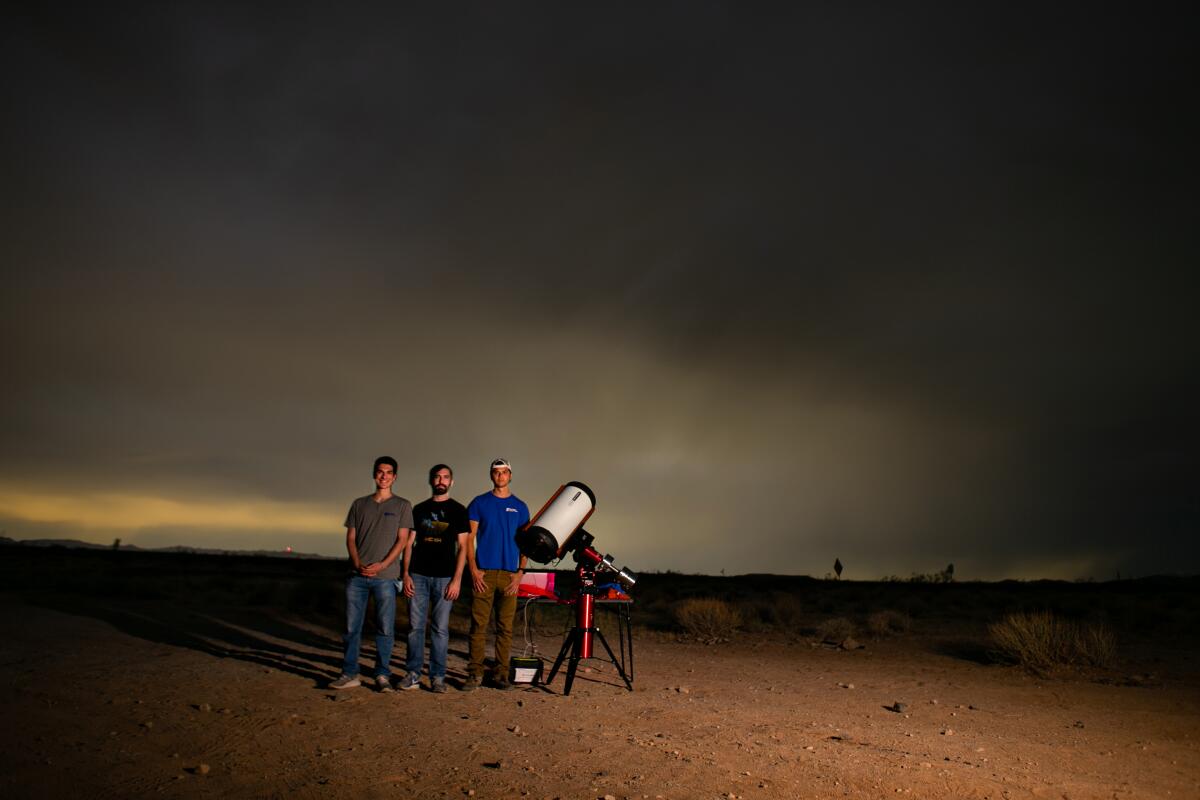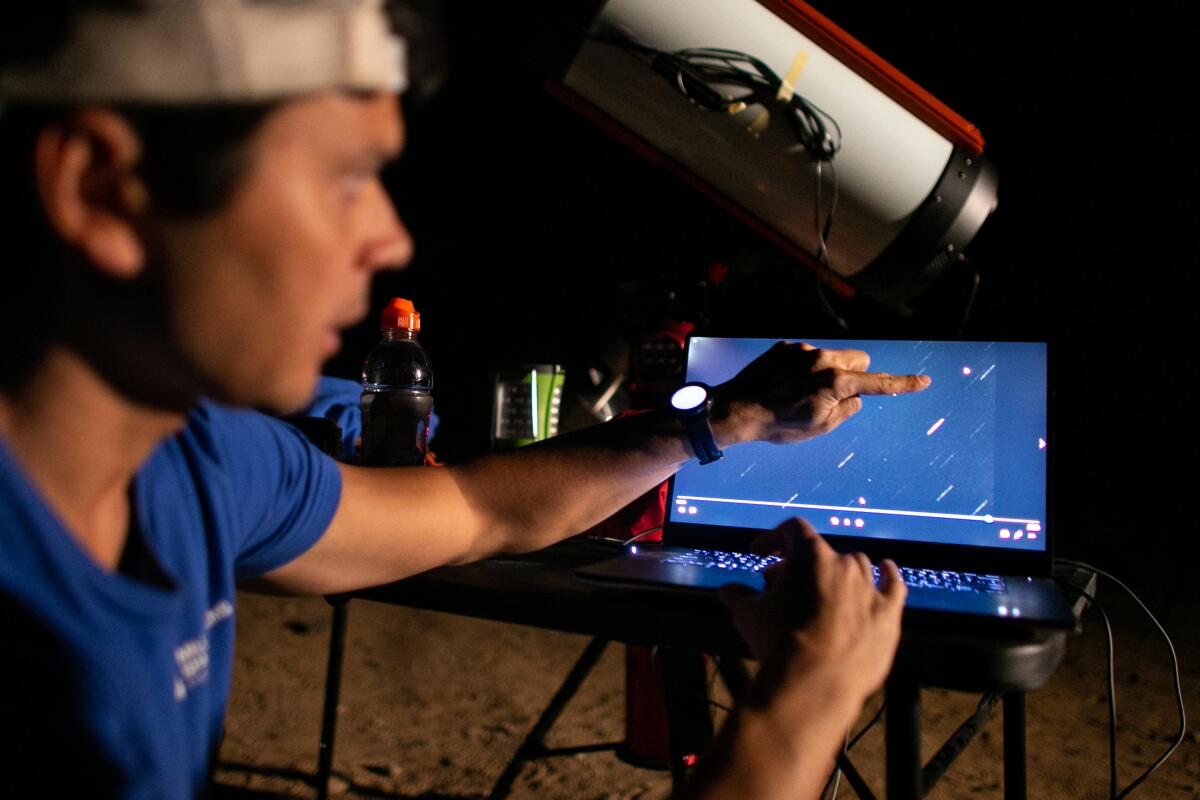A satellite’s impending fiery demise shows how important it is to keep space clean

- Share via
Space is vast. But the area around our planet is getting crowded.
New technologies and the proliferation of competing rocket companies have made it cheaper to reach low Earth orbit. But more objects in space can also mean more spacecraft-damaging collisions. That could jeopardize satellites that connect rural and underserved areas with broadband, as well as those that take images that help farmers track their crops’ health. It even could endanger the International Space Station, its astronauts and research aboard that could fuel cancer treatments and the creation of organs for transplant.
A too-cluttered sky could also get in astronomers’ way of learning more about the cosmos. And surrounding Earth with a continually denser layer of outmoded junk means that eventually there wouldn’t be room for the new, useful satellites of the future.
That’s why three engineers were out in Joshua Tree in the middle of the night last week. They’re part of a team exploring a possible solution: a device that would help satellite owners clean up after themselves.
Their goal that night? To track the impending fiery demise of a small satellite.
Alchemy — the name of the satellite soon to face its doom — was built by El Segundo-based Millennium Space Systems, a division of Boeing Co., to test a technology that would help drag spacecraft lower into the atmosphere to burn up after the craft’s mission is complete.
Alchemy was launched in November with its twin, Augury, which will serve as the control, demonstrating how much longer Alchemy would hang around as space junk without the new tech dragging it further down into the atmosphere. The program running this experiment has a tongue-in-cheek name: Dragracer.
“It’s definitely an appropriate name,” said Patrick Kelly, the Dragracer program manager. “They’re racing back to Earth. One has a very clear advantage over the other.”

Currently, long-dead satellites, spent rocket bodies and other pieces of outdated spacecraft float in orbit for years. There are about 23,000 pieces of space debris larger than a softball circling the planet, according to NASA. Objects that are too small to be tracked also pose a threat. NASA estimates there are 500,000 marble-sized pieces of junk in Earth’s orbit, along with more than 100 million that are 1 millimeter or smaller.
Joining that party are hordes of new satellites. Companies such as SpaceX and OneWeb have started launching satellites to low Earth orbit for broadband internet networks that are meant to provide connectivity worldwide, especially in areas that can’t be easily reached with fiber cables or cell towers. When complete, OneWeb’s “constellation” is set to comprise more than 600 satellites. SpaceX’s will be made of thousands.
We picked our favorite questions — now you get to choose which question we answer first.
“The rate at which we’re launching is increasing exponentially and is proposed to increase five to tenfold over the coming decade,” said Timiebi Aganaba, an assistant professor at Arizona State University’s School for the Future of Innovation in Society. “We don’t want to raise alarm by saying it’s so, so terrible, but the thing is, it potentially could be so, so terrible if we don’t do anything about ensuring that people think more sustainably about how to do space activities.”
From their living rooms and pickup trucks, amateur radio operators reach out to the International Space Station, circling 240 miles above Earth.
More space junk means the potential for more collisions, which in turn create more junk. Already, the International Space Station has had to maneuver itself to avoid debris 29 times since 1999, including three times last year alone. Even tiny objects can be a huge problem — space shuttle windows have had to be replaced because of damage caused by paint flecks whizzing through space and hitting them.
Astronomers fear the clutter could hurt optical astronomy and the cultural relationship people have with dark skies. Countries that dream of launching spacecraft for the first time may not have room to operate.
And there are now questions about whether space should be considered a human environment and thus subject to environmental laws.
The discussion becomes especially pertinent as the space industry discusses whether humans could — or should — become a multiplanetary species and how to establish other permanent space settlements. Already, some humans have lived in space since 2000 — the beginning of a 21-year uninterrupted streak of human inhabitation of the space station.
“We need to start thinking sustainably from Day 1 to ensure activities can continue in the long term,” Aganaba said.
Even SpaceX and Boeing, which have accomplished great engineering feats, are still grappling with the tech.
One option is to ensure spacecraft remove themselves from orbit. The Dragracer program’s Alchemy satellite is testing the efficacy of Terminator Tape, a box about the size of a DVD case that contains more than 220 feet of a folded-up film with an aluminum coating. One end of the film is attached to the inside of the box, the other end is attached to the box’s lid, and the box is connected to the satellite.
When the satellite stops being useful, it’s the box’s time to shine. Activated either by a person on the ground or by a timer, a release mechanism kicks out the box lid, unfurling the film. The film creates extra drag on the satellite, which accelerates the craft’s fiery return into the atmosphere.
The drag comes partly from the way the conductive film interacts with the Earth’s magnetic field and with plasma in the ionosphere, creating an electrodynamic force, said Rob Hoyt, founder and president of Tethers Unlimited, which makes the device. It also results from the satellite and film’s interaction with the particles of the thin, upper layers of Earth’s atmosphere.
The Alchemy satellite is expected to burn up as early as July, less than eight months after launch. The Augury satellite, which lacks the tape, is expected to stay in orbit for at least seven years.
Back in Joshua Tree, the engineers from Millennium Space Systems begin assembling their telescope to watch the progressing deorbit of the Alchemy satellite. They’ve done most of their observations from the parking lot of the company’s El Segundo headquarters and have collected a lot of data despite the light pollution and clouds in the area, Kelly said. But the desert has better visibility.
“It’s night and day,” he said. “We’ve been able to capture both Dragracer units with the sunlight glinting off it from this location. That’s just been really great.”

The team has been to this spot in Joshua Tree a few previous times and was able to see how much the Alchemy satellite has plummeted compared with the unchanging Augury. There’s usually been a good pass of the satellite between 2 a.m. and 4 a.m. The telescope is calibrated with whatever stars are visible in the sky — a challenge when there’s so much cloud cover, as there is on this weekday night.
“This tends to happen,” Kelly says. “We’ve got time before the actual pass.”
By 2:30 a.m., raindrops are plopping louder and harder. Tyler Ritz, an optical communications engineer, pulls out a golf umbrella and holds it over the telescope, while Kelly and intern Ian Silverberg cover the telescope with a parachute blanket.
By 3:15 a.m., the wind has picked up and the sky overhead is very cloudy. The team calls it at 3:45 a.m. and starts to pack up the telescope.
The impending demise of the Alchemy satellite will be “bittersweet,” Kelly says, particularly since he’s been there from the concept stage all the way until this satellite’s end. (The team will actively track the Augury satellite until this autumn to get a full year’s worth of data.)
“It’ll be really exciting to get that validation and confirmation to see how well the experiment worked out,” he said. “At the same time, it’s going to be a little sad to let it go and know that some of that excitement is coming to an end.”
There are other ways to deorbit satellites — such as thrusters that would guide the satellite further into the atmosphere at the end of its life — but the Terminator Tape used for the Dragracer satellites is intended to be cheaper and simpler, Hoyt said. (The device’s name is indeed inspired by the Terminator movie franchise.) So far, Terminator Tape units delivered have cost between $50,000 and $100,000, though Hoyt said future versions will cost less.
“We’re really trying to minimize the cost of ensuring that satellites get disposed of safely,” he said.
That disposal will be crucial for humanity’s next steps in space.
“As we gain more access to space,” Kelly said, “we’re putting more and more objects up there, so it’s becoming really important to make sure we’re using it intelligently and thoughtfully and not preventing ourselves from accessing it in the future.”

More to Read
Inside the business of entertainment
The Wide Shot brings you news, analysis and insights on everything from streaming wars to production — and what it all means for the future.
You may occasionally receive promotional content from the Los Angeles Times.













